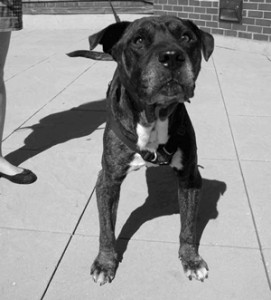A CASE FOR PROLOTHERAPY AND ITS PLACE IN VETERINARY MEDICINE

Multi joint Prolotherapy cases are common occurrences in the Canine. Many injuries and pathologies respond extremely well to treatments when several joints are treated verses just the site of primary injury.
This is not a tongue twister, but a veterinary confirmation challenge. Multi joint arthritis and drug sensitivity are issues not uncommon for the pit bull which make this breed a problematical anomaly to the owners and the veterinarians trying to treat them.
Osirus, an 11 year-old male neuter pit bull, was surrendered to the Humane society in the spring of 2010 after his owner had been relocated. When he was turned in, Osirus had a left partial ACL tear and a classic bilateral hip dysplasia, exhibited more prominently on the left hip.
His elbows were exhibiting signs of dysplasia as well. He was not using his left hind leg other than a peg, and had a heavy (3 out of 5) compensatory limp on the right front of his body. On physical exam, he was painful on palpation of all joints, and in his lower back as well.
We changed his diet, included EFA supplementation (Omega 3 fatty acids), and started (weekly) Adequan injections. We scheduled five Prolotherapy sessions three weeks apart and treated his knees, hips, elbows. By the third session, his gait was back to normal and all feet were properly bearing weight and placed firmly on the ground. On the sixth session, we included ACell1 in the protocol.
Within 10 days after those injections, Osirus was no longer painful on palpation of hips, knees, or elbows. In the five months since the last treatment, he has gradually improved and no additional Prolotherapy has been needed.
Osirus has regained normal mobility and gate. His limping has completely resolved and he is walking, running, and playing like a normal dog. His pain level has dissipated, without the use of drugs. His worst residual issue is a bit of stiffness sitting and standing.
Osirus could not stand up on his own prior to his treatments and has now returned to function; age related residual stiffness is merely a trivial affect.
Methods
We did six Prolotherapy treatments in all. Five were a series of injections of dextrose, lidocaine, vitamin B12, and (Heel’s) Traumeel in equal parts. The sixth was a combination treatment of the above, but the right hip and knee were also injected with ACell1 (5cc).
Normal needle size was 1.5-inch by 22 gauge for hip injections, and 1-inch by 25 gauge in and around the knee. Hip treatments of 5cc were injected at the dorsal and lateral aspect of the hip at four injection sites in and around the articular capsule, surrounding the femoral head of both hips.
Knee treatments of 5cc were injected in and around both knees. Injection sites for the knee: lateral tibial collateral ligament, under the infrapatellar bursa, into the tendon of the long digital extensor, and deeply into the joint space under the patella ligament.
Treatments took place approximately three weeks apart. Elbow treatments of 3cc were injected in and around the elbow.
Injection sites for the elbow: the radial head and the annular ligament, the external condyle of the humerus and articular ligament at the radial head, radial and lateral epicondyle at the lateral collateral ligament and the top of the lateral digital extensor on the lateral aspect of the elbow, and the joint capsule.
Conclusion
Polyarthritis and generalized lameness in older animals can be effectively addressed with Prolotherapy. Hips, knees, and elbows can be treated to improve ambulation, diminish pain, and improve overall comfort of the animal without using drugs, such as NSAIDs.
Using Acell1 to complete the Prolotherapy treatments enhances the overall healing of all areas and lengthens the time in between needed follow up visits. ACell1 also helps with the pain associated with both hip and elbow dysplasia. The cases where I add ACell to the protocol typically need fewer follow up visits for pain.
Download the complete article here:
A Case for Prolotherapy and Its Place in Veterinary Medicine (PDF)
ARTICLE ARCHIVE
- Journal of Prolotherapy,
Volume 3 | Issue 2 | May 2011 (PDF) - Dr. McCarthy, ACell Presentation (PPT)
- K-9 Joint Paper (PDF)
- Journal of Prolotherapy,
Volume 3 | Issue 1 | Feb 2011 (PDF) - Journal of Prolotherapy,
Volume 2 | Issue 3 | Aug 2010 (PDF) - Journal of Prolotherapy.
Volume 2 | Issue 2 | May 2010 (PDF) - Journal of Prolotherapy,
Volume 2 | Issue 1 | Feb 2010 (PDF) - Journal of Prolotherapy.
Volume 1 | Issue 4 | Nov 2009 (PDF)
- Journal of Prolotherapy.
Volume 1 | Issue 3 | Aug 2009 (PDF) - Journal of Prolotherapy,
Volume 1 | Issue 2 | May 2009 (PDF) - Journal of Prolotherapy.
Volume 1 | Issue 1 | Feb 2009 (PDF) - Senior Dogs, Understanding The Aging Process (PDF)
- Canine Acupuncture? Doc Says Dogs, Horses Can Benefit (PDF)
- Something Old & Something New (PDF)
- Theraputic Ultrasound – Its Role in Range of Motion and Trauma (PDF)
- Healing Horses, Trainers Try Alternative Therapy (PDF)
PUBLICATIONS
Nov. ’03 “Drug Free Alternatives For Your Race Horse” (PDF)
New York Thoroughbred Breeders, Inc.
April ’04 “Alternative Treatments Make Good Horse Sense” (PDF)
New York Thoroughbred Breeders, Inc.
May ’04 Published interview on alternative treatments for small animals
Long Island Press
June ’04 “Drug Free Management To Help Prevent Tying Up” (rhabdomyolysis” (PDF)
New York Thoroughbred Breeders, Inc.
July ’04 “Growing Pains for the Terrible Two’s: How to Deal with Bucked Shins” (PDF)
New York Thoroughbred Breeders, Inc.
October ’04 “Acupuncture Gaining Popularity Along Backstretch” (PDF)
The Pink Sheet
